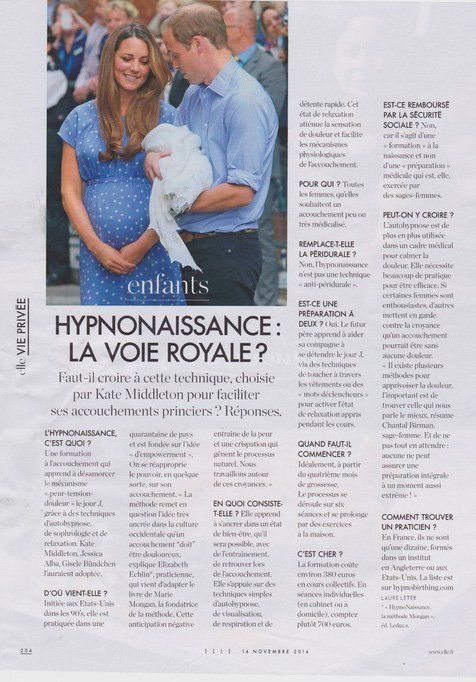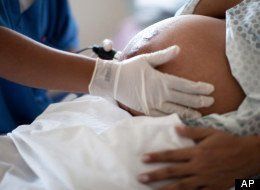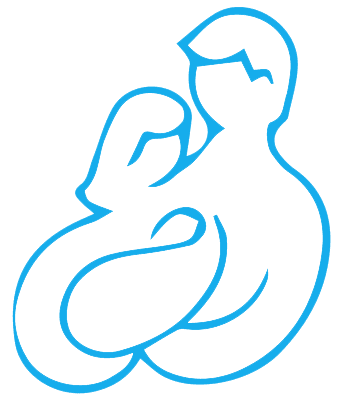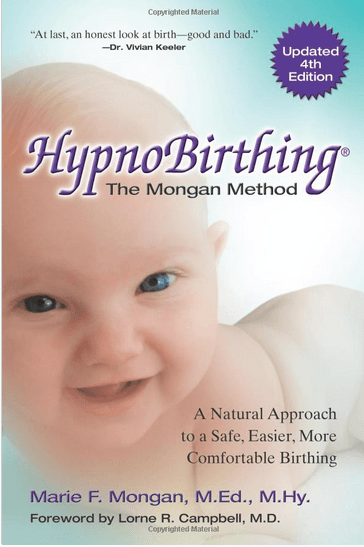

The benefits of HypnoBirth go well beyond birth
A short online survey collected information on 113 children, 72 of whom were born using HypnoBirth, and 41 were not. The survey was shared by HBCEs online using social media. Parents were asked to respond to each of their children.
The research confirms exactly what we knew about HypnoBirth babies:
- they are more likely to be calm (92% vs. 78%),
- satisfied (78% vs. 63%),
- alerts (99% vs. 85%) and
- happy babies (92% vs. 78%).
- good sleepers (71% vs. 54%)
- easy babies (83% vs. 61%).
These same traits were also apparent in older children.
- satisfied (83% vs. 63%),
- happy (97% vs. 83%)
- calm (70% vs. 57%),
- less picky (8% vs. 23%).
The majority of parents who responded to the survey felt that HypnoBirth had influenced their child's temperament. Numerous stories testify that the babies who entered the quiet world and the alert, have remained.
"I am 100% certain that Grace's acute perception, rapid language development, extreme kindness and sociability and behavior are directly related to the calm and natural birth she has experienced. "home" from the moment she was born. "
"From the moment my daughter was born, she was sweet and kind and she is still four years old, she was a happy and easy baby and still is."
"When he was born, he was put on my chest and he looked me straight in the eye, he never cried, he was so alert and yet so calm, I firmly believe that the HypnoBirth had a lot to do with it! "
The full report is available at:
The benefits of HypnoBirth go well beyond birth
Remember, little Lou
This ChouChou |April 27, 2012
I did not expect this.
Today, I took my Loupiote to the osteopath. It was a first for her as much as for me. In my head, the osteopath was only a kind of physiotherapist and I drove my daughter today to see if it was possible to make him pass this ugly hiccup she has constantly. That was all.
Instead, we went back in time. The osteo, a young woman, asks me first of all how was my delivery. I explain that I was triggered. In my arms, Lou begins to stir and I see the young woman throw him a few glances. Before going into details, I said that the outbreak was very complicated but the delivery was then simple and fast. In my arms, Lou began to cry and stiffen, she is very tense. The osteo interrupts me, looks at Lou and says to me: "It is she who will tell us the continuation, she reacts very strongly when you speak about it".
At that moment I wondered if I had not fallen at the only osteo esoteric corner. How could a 6-week-old baby tell the day of his birth? I lay Lou on the Bibeddu cabinet, I put body. The osteo invited me to sit next to the desk in a chair and then began to communicate with my daughter. First by very wide gestures around her, to hang her eyes. Then closer and closer to putting his hand on his belly. She introduced herself, told him what they would do together. That she was going to help him evacuate all the tensions of his birth. I already had a heart on the edge of my lips. Because if Lou was preparing to come back on March 13th, I would go back there too. Pain. The false work that did not end, for hours. Fear, cries, tears, exhaustion. And this pain, again and again, endless.
Lou was very calm. The osteo manipulated her a little, sometimes loosening her thumb a little too much, sometimes releasing her left leg from a latent tension. Then she wrapped it on herself, in the position she had just before birth, and that's when it all started, with little grunts of discomfort. The osteo, while feeling very slightly the body of my baby, began to pose against it various small bottles for a few seconds. The first two had no effect. In the 3rd, Lou began to cry, in a way still completely unknown to my ears. I heard fear in her screams, an intense fear. Panic mixed with incomprehension, it was very strange. She was moving in all directions, her mouth was frantically seeking the breast. The osteo looked at me to reassure me, I did not say anything, I trusted ... She rested the bottle, the tears were calmed. The 4th had no effect too, but the 5th made the tears start again. The 6th amplified the phenomenon to lead my daughter to anger. Strident weeping, his whole body stiffens with the effort.
The osteo put the bottles on the table and I took a quick look. On the 3rd, we could read "Oxytocin". On the 5th, "Morphine". On the 6th, "Peridural SN". For the duration of the operation, the young woman had spoken to Lou slowly. As she was putting down the oxytocin bottle and my daughter was crying, she said, "Yes, you were taken aback, you did not think about it like that". In my chair, I could not contain my tears ... no, that's right, we had not considered things like that. Everything had started so well ... and then the cholestasis, the anxiety to lose it forever, the treatments, the trigger. No, no one had considered things like that.
The osteo continues his manipulations and returns Lou lying down. She begins to compress some parts of her body. She will explain to me at the end of the session that at this moment, she simulated the contractions acting on Lou's body inside the belly. For the second time, screams. My daughter had entered at the moment in intense anger. His legs, completely stiff and hard as wood, grew in the vacuum at regular intervals. The osteo gradually refocuses one of his hands to the forehead of my baby, and continues to compress the other key areas of his body. And Lou is still screaming. She is in a terrible anger, chained spasm, becomes redder than ever and this air of incomprehension in her tears is felt again. Moments later, the osteo tells her that she has worked well, that it will get better now that she "cried her memories" and that all the tensions of childbirth have been evacuated. My little girl falls asleep at once, the osteo resumes the manipulations and Lou will not wake up to the house.
I looked at the scene haughtily, without saying a word. Not a minute I was afraid for her, because I saw right away that she unload something remained probably locked there, in her, since the first day. It was so impressive. Once Lou was asleep, the osteo translated everything I had just seen: "Your trigger did not work immediately. You spent a lot of hours doing false work, you shouted a lot and cried, the pain was extremely violent. You took morphine. It was the epidural injection that ended the ordeal and Lou arrived. "I listened, a little numb. I was not involved in the details, the process of my release was recorded nowhere in the documents she had in hand at the beginning of the session. She went on to explain to me that all the inflections of voices heard for an hour in the tears of my daughter told us how she had lived the delivery. First fear and misunderstanding, with this discharge of hormones that from one minute to another tried to put her on the door of her cocoon when she was not ready to leave. Then the thrusts on her legs to go out, the skull that supports and tries to open the way since it was forced to do so, but this collar that did not open and this little baby who stumbled constantly against the door remaining desperately closed. Misunderstanding giving way to anger. Then, finally, the epidural. The beginning of the real work, the descent, the exit. And finally, Mom. Appeasement.
This whole day of false work where my daughter stumbled, again and again, on the closed collar refusing to move arise all the little worries she showed: by beating the top of the skull on the cervix, a contracture had formed between the shoulder blades. That's why I found it painful when I manipulated it for bathing or changing it. The contractions of the false work occurring every minute for nearly 11 hours without any possibility of respite and more violent than the others, having compressed too often, too much, too long, his stomach had moved slightly, raising his diaphragm. That's why she always had hiccups as soon as she was handled a little too quickly after a feed and she regurgitated often.
Before dressing it, the osteo poured a few drops of each of the bottles into very small plastic bags and carefully closed them again. She explained to me that the sudden influx of toxins in utero at the time of the outbreak had fouled the liver of my baby, the only organ able to treat their elimination but still too little mature at this stage to perform this drainage properly. She hung the small bags at a button of the body and told me to leave them well, night and day, for 9 full days: the contact with the molecule, the body will resume the process of elimination started during the childbirth and thus cleanse the liver of all leftover product. Incidentally, his infant acne should disappear, since it is systematically due to the liver and the bad elimination of certain toxins at the beginning of the life. I will have learned some things today ...
That was our first osteo session. A machine to go back in time ... and I understand better now everything that has happened since birth. This constant need of my daughter to be against me, this immediate appeasement induced by the portage, her sleep much better when one is in cododo. It has been torn from its case and these situations are all ways for her to find him. My need, for me, to fill this 9th month so brutally interrupted by wrapping my baby with my arms, sleeping with her, keeping her close to me. At the time of writing, she is sleeping. She could just as well be in her bed, or in bed, why not. But no. I keep it there, all against me, in the sling. Within reach of hug. And within reach of my tears that I have struggled to contain since this morning. That day, she had pain, she was afraid ... what happened is not my fault, but I always ask forgiveness for these first difficult moments.
And I tell her that everything is fine now, that she must not worry.
I tell him that Mom is here.
Lou, my baby so wise, 6 weeks to this day.
MOM TEST
2013/03/10
The tree and the nest: To reflect on the birth in Quebec
At the end of a birth, a midwife should examine the placenta to make sure it is intact. We can then notice that this organ, real nest for the baby, looks like a tree where the cord forms the trunk and the irregularities of the placenta foliage. This is the image of a great poetry that opens the film The tree and the nest of the director Valérie Pouyanne which I had the chance to attend this March 8, International Women's Day, thanks at the invitation of the Regroupement Naissance-Renaissance.
We could not have chosen a better day for the premiere of this film because it is a reflection on the situation of deliveries in Quebec. As has been said in many forums, the right of a woman to choose how she will give birth is indeed at the heart of feminist claims.
Unfortunately, in Quebec, many women are not so lucky. If 25% of women want to give birth at home, only 2% succeed. In addition, it can be assumed that the lack of knowledge and myths surrounding midwifery prevents many women from making a truly informed choice. Indeed, as mentioned by Christiane Léonard, midwife, to make such a choice, one must be informed.
For example, many people still believe that home birth or birthing is risky, while low-risk pregnancies are not, as Guy-Paul Gagné, a gynecologist, points out. So we are in a situation where almost all women give birth in the hospital and there are the many interventions associated with it.
According to Jean Zegby, General Practitioner, Palliative Care Specialist and President of the Canadian Association of Physicians for the Environment, this is because doctors are first and foremost trained to act when a delivery becomes complicated. . They see childbirth as an event that can go wrong at any time. In such a context, the doctor feels compelled to intervene because he is more likely to be blamed if he does nothing and something goes wrong if he intervenes unnecessarily and it creates complications.
All the actors of the film agree to say that it is essential to return to a physiological and normal vision of childbirth. According to Michel Odent, gynecologist, researcher and author, this is imperative if we do not want, in a few generations, cesarean section is the normal way to put babies into the world. Finally, as this one mentions, it is an important reflection not only for the perinatal interveners but for all those who are interested in the future of humanity.
The tree and the nest is therefore an exceptional and necessary film. In addition to showing us beautiful images of natural childbirth, it offers many avenues for reflection on how to experience childbirth in Quebec. This is a film that should be seen by anyone interested in the right of women to live the birth they want.
To see The tree and the nest:
March 11, benefit evening at the Guzzo cinema in Laval www.mieuxnaitre.org/nid
From March 15: at Beaubien Cinema, Guzzo Theater in Laval and Guzzo de Longueuil
From March 22nd: at the Cartier Cinema in Quebec City
To visit the official website of the film: http://www.arbre-et-nid.com/
Written by Kathleen Couillard at 09:10 0 comments
Email ThisBlogThis! Share to TwitterShare to Facebook
The Gazette of CentheA
Winter 2012
HypnoBirthing® another way of being born
HypnoNaissance® was created in 1990 in the USA by Marie Mongan. It is a relaxing and rewarding method to give birth without stress and without medication, based on the belief that all babies should come into the world in an atmosphere of gentleness, calm and joy. When a future mother is well prepared spiritually, mentally and physically to give birth, she can live this happy experience in an easier, more comfortable and often painless way. Through a well-designed program of deep relaxation, self-hypnosis and education, HypnoBirth gives back to the woman the power to give birth by appealing to her natural instinct.
Until recent years, the idea of such a birth was out of reach for most pregnant women. Even today, the majority of women are convinced that birth is a medical event and that in a way, their bodies are flawed and may not work properly.
Even women considered "safe" are led to believe that the birth of their baby must be handled chemically and chronologically. They give up their babies and their childbirth energy to someone else, often a stranger, without realizing that this type of birth influences the development of their baby and leaves an indelible mark that will mark the child's entire life. .
In HypnoBirth we know that, almost from the moment of conception, babies are conscious and know what is going on around them; and they remember their birth. For 22 years now, HypnoBirth has given an entirely new face to this magical birth event. This method aims to give women the opportunity to experience the joy of giving birth in a truly safe, comfortable and satisfying way for themselves and their babies by trusting in their own bodies and babies.
Thanks to the information that couples will receive during the courses in HypnoBirth, they can realize the importance of planning, preparing and directing the birth of their baby so that this indelible imprint is for him a joyful imprint.

According to scienceblog.com,
this is the conclusion of researchers from the University of Copenhagen and the
Research Unit for General Practice. The statistician Ole Olsen and the specialist
of obstetrics Jette Aaroe Clausen are categorical. All countries should
take into consideration the introduction of a home birth service.
The study mentions that too many countries mistakenly believe that the safest place for childbirth is the hospital. However, what the study reveals is that women who have a normal pregnancy, and therefore low risk of
complications during delivery, should stay at home.
In fact, a woman who gives birth at home will not have any care deemed unnecessary such as the heart monitor for the child and the epidural.
On the other hand, as stress is less present, complications are greatly
decreased, for example, in relation to cesarean section.
Of course, the mother-to-be will be accompanied by a midwife who, for her part, will be in contact with the hospital services if emergency transfer is required. For the moment, however, this service represents a major gap in the majority of hospitals.
Olsen hopes that the countries will be there soon: "In several Danish regions, the delivery service at home has been very well organized for many years.
This is unfortunately not the case in the rest of the world.

Epidural, yes or no?
Epidural - dreamstime.com
Pain and Suffering - Epidural and Physical Relief
- What is it really and what should we expect?
Epidural anesthesia remains the most popular form of pain relief during
work. It is a gesture of comfort whose purpose is to suppress or reduce the pain of childbirth by blocking the nerve conduction by injection of a local anesthetic in the epidural space (located in the spinal canal) in contact with nerve roots from the uterus. The epidural is offered almost systematically to women who give birth at the hospital and who do not wish to physically feel the pain of contractions and childbirth. Women in labor with an epidural are awake and alert, but they feel more or less physical pain.
Pain
The medical staff strongly recommends the use of the epidural because the mother is calmer and seems more comfortable. This translates into less physical presence on these sides for hospital staff, who are often understaffed.
Many pregnant women make the choice in advance of the epidural in agreement with their doctor or midwife, with the certainty that the birth of their child will be done without physical pain and peacefully. However, some women say they were surprised by the physical and mental situation that they had to face despite the laying of an epidural. Many negative effects of the epidural have been mentioned since his
use in obstetric environment. One of the side effects is that it slows the natural progression of work and often leads to other medical interventions. (Forceps, suction cup, cesarean section etc.).
But are not the possible side effects outweighed by the positive effect of pain-free work?
Cortisol, adrenaline and endorphin
Pain is a natural and necessary part of the job since it sends the signal to the woman's body to produce endorphin, a hormone that fights physical pain and stress. After the epidural, the body continues to produce cortisol, since it is still under stress (uterine contractions). Cortisol is a steroid hormone that is released into the body in response to physical or psychological stress. However, the mother no longer naturally produces endorphin since her body no longer sends the signal. In response to stress, the body secretes adrenaline that naturally slows down work.
Pain or suffering?
In a study (1), researchers have shown that the epiduralmost oftencontrolspain but that some women are still inpain. Relieving or eliminating pain does not necessarily rhyme with suppressing suffering. Women need continued moral support even though they seem
physically comfortable. They often complain about being left alone. The presence of the medical staff, the partner
and a doula
remains paramount. Massages and distracting conversations allow the body to relax and continue to secrete "the hormones of well-being".
Many expectant mothers describe their distress because of itching,
numbness, nausea and all the side effects of the epidural. Women are also concerned about the well-being of their baby. A common effect of epidural anesthesia is the lowering of the baby's heart rate. Even though the hospital staff responds quickly to these alerts, it is still very scary for a future mother.
Moral distress
The threshold of moral distress related to active labor, even when the pain has been reduced or eliminated, is almost identical to that of women without analgesia. In fact, women who use an epidural express the fact that they need as much support as women who give birth naturally.
The importance of the moral support received during childbirth is more important in a way
general, that the management of physical pain. This ongoing support is essential and many women conclude that they are happier with their experiences without medication to control pain. It's not the drug or the lack of medicine that made the difference, but the presence of someone to give continued moral support.
References: Studies: (1) Wuitchik M, et al. (1990) Relationships between pain, cognitive activity, and epidural analgesia in labor. Bread 41: 136-142







